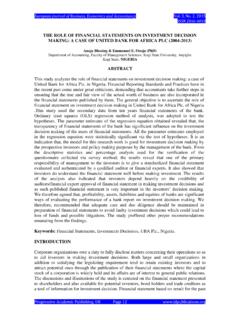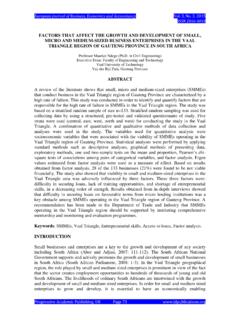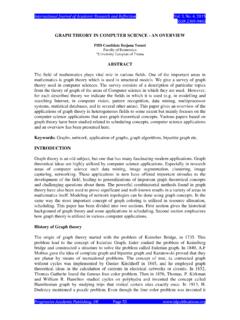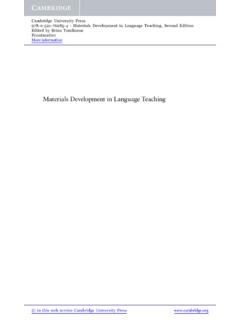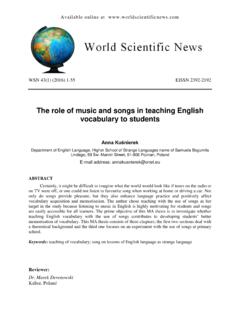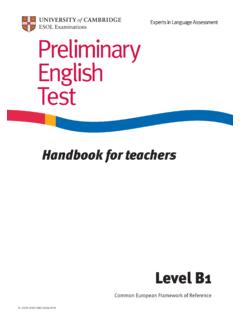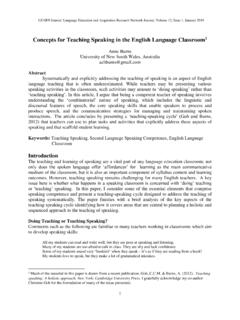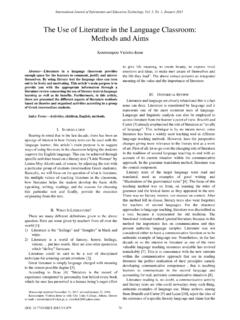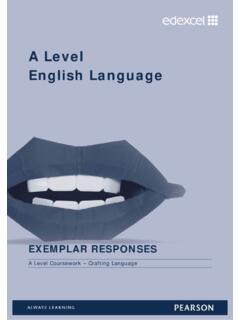Transcription of AN ANALYSIS OF SYNTACTIC ERRORS COMMITTED BY …
1 European Journal of english language , Linguistics and Literature Vol. 3 No. 1, 2016 ISSN 2059-2027 Progressive Academic Publishing, UK Page 1 AN ANALYSIS OF SYNTACTIC ERRORS COMMITTED BY STUDENTS OF english language CLASS IN THE WRITTEN COMPOSITION OF MUTAH UNIVERSITY: A CASE STUDY Dr. Hemabati Ngangbam ( english language teaching and Learning) english Department, Faculty of Arts, Hail University, KSA ABSTRACT This paper examined the english SYNTACTIC problems persistent in the written performance of freshmen english language class of Mutah University. Subjects were 60 native Arabic speaking students. 15 categories of ERRORS were classified to find out the causes of SYNTACTIC error, which type of ERRORS are more frequent, areas of weaknesses and problems tend to occur in writing compositions.
2 Results indicate performance problems COMMITTED in this study were due to mother tongue interference, misuse sentence fragment, overuse, lack of grammatical knowledge, formation and developmental ERRORS . Keywords: Error ANALYSIS , SYNTACTIC Error, english as a Foreign language Learners (EFL). INTRODUCTION The aim of teaching a language irrespective of either english , Arabic, Hindi, Chinese or Russian etc. is to make the learners proficient in some or all of the basic language skills, that is speaking, reading, writing and understanding. Since fifties onwards, researchers have paid increasing attention to the structural and functional language changes.
3 A number of issues in study of expressive syntax in school-age children and adolescents that contrast with studies of younger children-issues have an impact on attempts to develop and interpret a normative database Scott (1988). The modern roots of the syntax can be traced to the pioneering work of Noam Chomsky, who in 1957 wrote SYNTACTIC structures. As writing is a continuous complex process of expressions. It is not itself a simple process with its native language and rather even more a complicated process if the language is a foreign language . A number of studies conclude with the impact or interference with their first language during the process of writing in english .
4 Studies done by Cedar (2004); Chen & Huang (2003); Benson (2002); Collins (2002), Seyyed ( 2012), Neda Ghabool (2012) and Jarvis (2000), all supports this phenomena. Likewise, with any other learners of english as Foreign language (EFL), the english in the Arab countries was expected to have its impact with its Arabic language interference. A text is determined legal by the language of syntax and the disagreements with the SYNTACTIC rules are called syntax error. This judgment can easily be detected by our knowledge of language but one purpose of a theory of syntax is to possess the structural sentence as acceptable or not.
5 Susana (2007), describes SYNTACTIC complexity as the ability to produce writing that shows how ideas and large chunks of information are represented with the use of subordinate and embedded subordinate clauses. Syntax complexity is one of the most difficult structural elements for ESL/EFL learners. Scott (1998), identified a number of issues in the study of expressive syntax. Among these were; SYNTACTIC structures added and developed in this period occur less frequently in the ambient language . European Journal of english language , Linguistics and Literature Vol. 3 No. 1, 2016 ISSN 2059-2027 Progressive Academic Publishing, UK Page 2 The number of discourse contexts for studying syntax increases, (eg.)
6 Written as well as spoken language , and informational in addition to narrative and conversational discourse). Thus, this paper is a modest attempt to bring a broader discussion of what defines normal SYNTACTIC ability in university age children and adolescents especially focusing on second language learners of english in particular Arabic speakers. This study will help to find the continuing SYNTACTIC growth in the service of more effective discourse, either spoken or written. Hence, this type of research should be viewed as significant because it reflects the features that distinguish the Arabs' english as a performance variety which develops where english is used as a foreign language , Kachru (1983).
7 Investigating in these areas may continue to persist the specific difficulties face by the Arab learners of english as a second language at the beginning of their college education. REVIEW OF RELATED LITERATURE A wide range of materials have been found relating this present study. And considering the main purpose, only a few studies have been selected for reviews. Research dealt with investigating the ERRORS produced by second language learners of english have been selected in a way that investigating this subject choice can diagnose the areas of weakness and strength in learners' english . As already mentioned, the role of the first language has long been considered as the main obstacle to a successful learning of another foreign language .
8 Eventually, the context of english in the Arab countries does also have its impact on the type of english learned, due to the Arabic english interference. Therefore, a better understanding of the first language (L1) influence in the process of EFL writing might help the teachers to know students difficulties in learning english . Khaleel (1985) analysed the written ERRORS of Bethlehem university students in the first year of their college education on the West Bank. He distinguished between grammatical ERRORS , , word order, concord and verb, and semantic ERRORS , , lexis and collocation. The latter was found to impede communication.
9 Kharma (1983), studied the SYNTACTIC difficulties faced by the Kuweiti high school students. His study was based on contrastive ANALYSIS of english and Arabic. He devised a test focusing on the problem areas and sorted out the frequency and types of the structural ERRORS which were mostly related to tense. Kambal (1980) studied the written ERRORS of the Khartoum university students in Sudan and found that their ERRORS fell in the areas of tense, verb formation, articles, concord and prepositions. To discover learning deficiencies in writing english , Kao (1999) scrutinized 169 compositions from 53 Taiwanese college students who were english major students.
10 A total of 928 ERRORS were found among which grammatical ERRORS with the greatest frequency of 66 per cent, semantic ERRORS occurred 18 per cent of the time, and lexical ERRORS occurred with the least frequency of 16 per cent. Lin (2002) also examined 26 essays from Taiwanese EFL students at the college level. The results of this study indicated that the four highest error frequencies were sentence structures ( per cent) wrong verb forms ( per cent), sentence fragments ( per cent), and wrong use of words ( per cent) respectively. In a study by Kobayashi and Rinnert (1992), comparing translation as a strategy in L2 composing vs.




